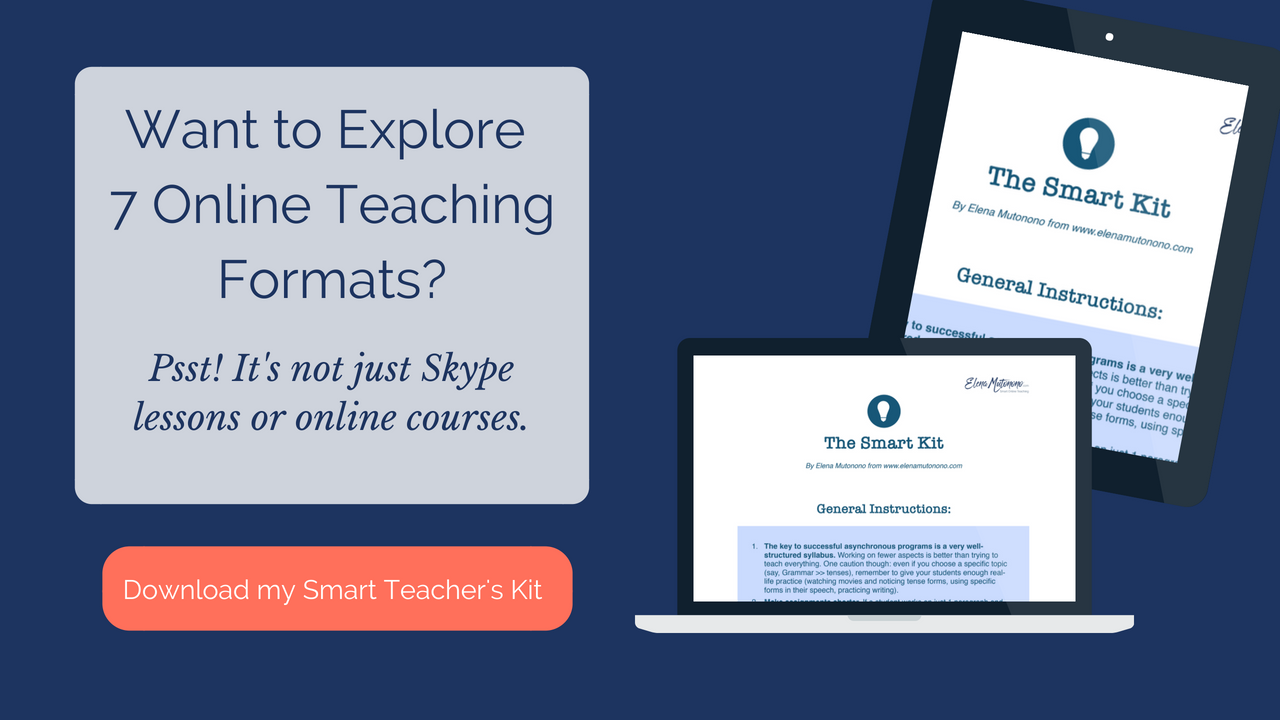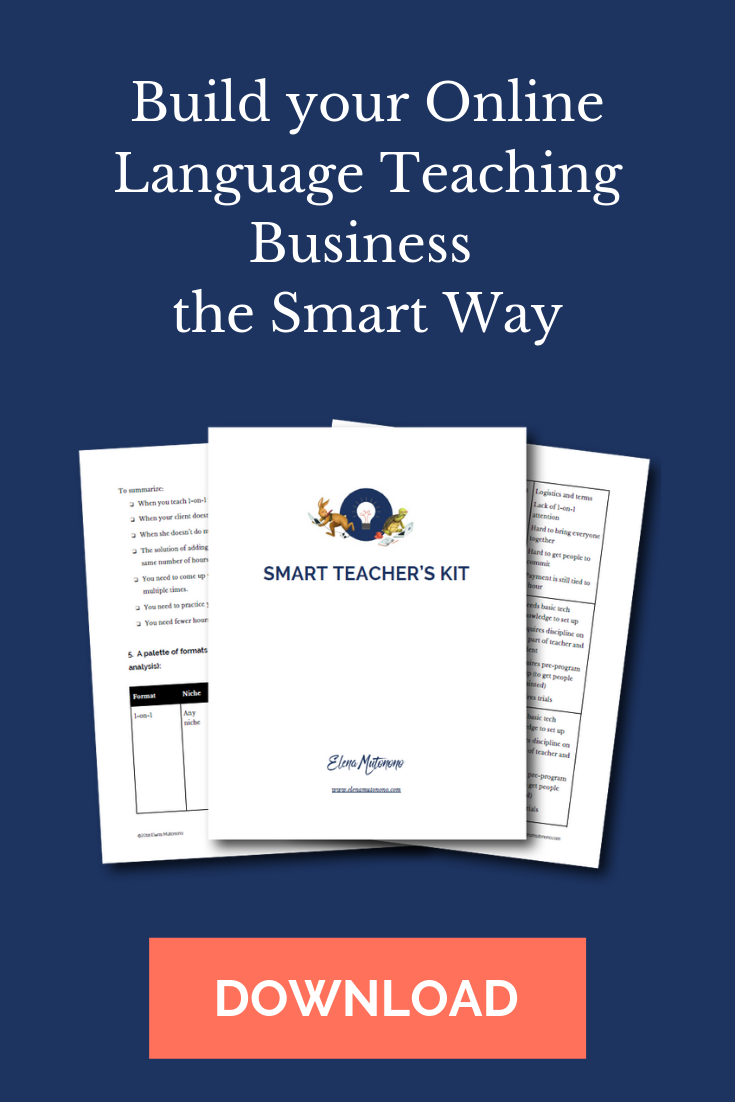*** the post was updated in February, 2022 ***
Imagine a picture without focus. Sometimes it can be called art, but even experienced photographers know that you can’t do an entire photoshoot without focus. You need to zoom in on something or else your picture will be blurry. Online teaching without a niche is like a picture without focus.
Niche finding makes the work of online teachers very easy. Once you decide what you want to do and who you want to deliver your content to you’re no longer going to worry about what to write on your blog or what your next online course should be about. You will also become an expert that will solve specific problems of specific people.
It’s like going to see a specialist when you have a particular health issue vs. seeing some generic doctor. It seems to me that these days there’s an overflow of generic doctors in the area of online education. What we need is specialists helping with specific problems, and those are so rare.
Online English teachers for instance might start out and say, “I want to teach Business English” or “I want to teach Conversational English,” or “I want to teach real English,” or “I want to teach pronunciation,” but even these areas are too wide. We must narrow down, down, down.
I’ve noticed from my own experience and that of my colleagues that unless you have some coaching at the beginning of your career it may take you at least a year to find your niche, in most cases a lot more.
So today I’m addressing the issue of niche finding, and I hope that this content will be helpful to you and that it will in fact help you narrow down your niche.
Growing your business starts with identifying your niche. Check out this guide to help you find focus.Click To Tweet
Why is the idea of niche finding so hard?
From my chats with other online teachers, I have discovered that even after reading countless blog entries, taking classes and discussing the matter on forums they still find themselves in the dark about this niche-finding process. Usually what is meant by niche finding is:
a) finding some area that (preferably) hasn’t been taken by any other language teacher;
b) finding some area where you are more experienced and knowledgeable than all the rest of your competitors;
c) finding an area that is very much in demand
So why are the above criteria still confusing and vague? The most obvious reason would be we cannot always know exactly what our competition is doing. If I’m an online English teacher I put myself into a broad category where I’m competing against thousands upon thousands great English teachers, many of whom are much better than myself.
I mean, let’s face it. I’m not a native speaker, and no matter how much I love linguistics, and specifically teaching English, it will never be as easy for me to promote myself as for a native speaker who can get a TESL certificate within a matter of weeks, put together a website and recruit a great number of students just because he/she has got the “I’m the native speaker” written across his every blog entry or promotional pamphlet.
Now, I’m not downplaying the native speaking English teachers, in fact, I believe their input is extremely valuable. I’ve been privileged to work with some excellent and highly qualified native speakers who complement my syllabus greatly.
But I still find myself a bit at a loss when I see how “I’m a native speaker” (and in fine print: I’m a student, too who just needs some extra cash) can be more attractive than “I’m experienced, highly qualified, have developed online courses and trained hundreds of students, and my customer satisfaction rate has consistently been 98% over the 5 years of work).
And I’m sure that native speaking teachers might be asking themselves, “How can I attract beginner students when I don’t speak their language?” “How can I be successful with a group of students whose teaching style expectations might be totally opposite of what I am accustomed to?”
As we know learner’s expectations can be a strong motivation for or against language learning with a particular teacher. Some students like a lot of hefty Grammar exercises and expect endless corrections, others want to just have fun and enjoy the ride.
So after looking at a dozen of websites of other online teachers I often feel overwhelmed and inadequate. How can I possible find my niche when lots of people are doing this English teaching much better than myself? Perhaps then our niche-finding must start with looking at ourselves more so than assessing your competition and trying to “beat them?”
Maybe we should ask our clients first, instead of trying to find out what is it that the rest of the world actually wants? Plus, we all have to keep in mind that our path might change as we seek to solve our customer’s problems. We might find ourselves moving from working with one group of students to helping another one; we may even switch our primary focus because our clients will ask us if we could help them with it.
Based on these observations and my own 5-year experience of online teaching (and endless niche-finding) I have come up with this simple action checklist of guidelines that have been extremely helpful for me, and I hope it will help you, too.
Niche finding: A practical checklist
#1. Define 3 main language aspects that you love teaching.
Some people love Grammar, others – vocabulary, there are those who enjoy teaching pronunciation or accent training. Now, I know that “loving” can also sound rather vague. By “loving” I mean losing your time and appetite while working on it.
Loving means spending money on a valuable book/webinar, workshop, training, conference without regret. Loving means being willing to offer a small version of your course in the area of your expertise for free. Loving is the desire to talk endlessly on the subject of your choice. Unless you’re in the teaching business temporarily, I’m sure you can easily find 3 and more areas that you love teaching. Do that!
Once you define those 3 aspects write down why you love teaching them and how in your opinion you bring teaching of these aspects alive. Perhaps you have a set of wonderful visual aids for teaching vocabulary. You may have never posted them, but they have helped you and your students. Perhaps you can make the boring Grammar rules easy! Be specific and put down as many details as you can.
#2. Define your style.
Even if all ESL teachers are presently focusing on the same subject (e.g. Present Continuous) there are myriads of ways of presenting this same information. Some can do an infographics, others can create unique exercises, some might rap this information, others put on a wig and act it out. Some create videos, others – podcasts. Some write a list of rules, others – write a poem.
Many times I’ve tried to be like somebody else. I mean, I wish I could rap like Jason R. Levine, I wish I could produce funny videos like Vicki Hollett, I wish I could produce the same excellent quality podcasts like Kerstin Cable does on Fluent Language, and the list goes on. But this is just not my style.
I can’t rap to save my life, I don’t feel like my natural teaching style is that of an entertainer, and I’m not sure that I can consistently put together 1-hour long podcasts on a weekly basis.
And you know what? I don’t have to! And neither do you. While some students love their teachers to be crazy, artistic, and fantastically entertaining, others don’t. My style is perhaps more reserved and academic at times, but I do try to make my materials highly structured and easy.
And my students don’t have to be put out of their comfort zone by me forcing them to do something they are not so sure about (i.e. rapping). I cannot imagine my clients doing that. I just have different kinds of clients that were attracted to me because I don’t rap, don’t song, don’t entertain, but teach them what they need in other ways. So, you don’t have to be somebody else.
Be yourself, but first discover what it is that defines your teaching style!
#3. Ask your students what they love most about your teaching, the content of your lessons and why they choose you.
This is pretty much a development of my previous point. I trust that you have done some teaching prior to developing this online venture, so write to your former (or current) clients and ask them why they chose you.
I did this experiment a few months ago, and was blown away by the answers! Not only did I get a lot of positive feedback that is extremely encouraging and empowering, but I received some useful information about myself and my teaching style that I sort of took for granted and thought it was very basic and similar to everybody else. Let me give you just one example.
For some reason I thought that my students would say something like, “We like your classes over other teachers because you offer excellent customer service and loyalty and referral discounts.” That’s what I thought, but none of the 5 respondents (who are my loyal customers) mentioned that (What?) Instead they said, “We like you because you care about your customers and your care is reflected in the materials you design.”
They said, “We chose you because you know how to motivate, and you always do it in a very tactical way.“
They said, “We chose you because your materials are on the technological cutting edge, and you offer us the opportunity to learn anything, anywhere and at any time.” The amazing thing is that such kind of feedback can give you guidance on how to promote yourself.
So, instead of advertising myself as somebody who offers excellent customer service (which I will still do), I will use my students’ feedback to create my promotional campaign. Use their very words to be more specific and to strike a chord with other students who might be looking for the same thing.
#4. Ask your students if they only had 1 question to ask you about language learning, what would that be?
One of the promotional strategies that I’ve seen some online teachers set up is offer your students 15-minute FREE consultations where you can answer their most pressing questions in the areas of language learning.
These consultants set up a page online with a questionnaire (you can use any free forms sites out there, like Google forms or Jotform) and then ask your students to fill it out. You may have more than you can handle, so decide for yourself how many you’d like to approve.
No matter how many you help (5 or 10 or 20), you will still have their valuable forms at your disposal, and that will help you define what is it that these students need and what you an offer to them in the future. Take time to create the questionnaire and make it as precise as possible so the answers can be truly helpful.
#5. Create a FREE “add-on pack” that will include a more detailed answer(s) to your students’ questions.
So let’s say that the majority of your students have trouble with phrasal verbs – they seem to need some practical advice on how to memorize them, how to use them and when to use them.
And it turns out that phrasal verbs is one of your most favorite things to teach! So this is where you do some research and/or pull out your old resources and give them a second look. Organize them into a new system. Format them. Save them as a nice PDF-file. Add a podcast, if you like, to make it more personal (your podcast doesn’t have to be super-long, 5 minutes will do). For more ideas check out this post.
Make your materials really easy to follow and add some assignment after that with the answer key. Give your students some time to process this information and then follow it up by offering 15-minute paid consultations to see whether they understood the information well. Or set up a webinar or a conference call to cut on the cost, but be sure to make that first sale after loading your prospects with your fantastic free material!
Be consistent in keeping in touch with your clients and continue offering them those “up-sells” and constantly give them something absolutely valuable that they can’t get from anywhere else. This is when you look at other people’s websites and resources and ask yourself, “What can I do better?” “How can I improve on what’s already there?” “Why do I not like the traditional textbooks on this subject?” Be specific, write your observations down and continue developing your niche.
Be patient with yourself as you try to narrow down your niche. It may take some time until you’re confident that what you offer to your students is truly unique.
It takes awhile to find that perfect segment, but if you’re in this online teaching for the long haul, it’s well worth it.
I hope today’s post gave you some tips and ideas as to what you can do to zoom in. Please share if you find it useful.




 Welcome to my nook where *Big Magic* happens. My name is Elena Mutonono, I help small business owners package their services as digital products and sell them online. I want you to work smarter, not harder. Increase your impact beyond your current face-to-face clients. Grow your business as you reach more people all over the world.
Welcome to my nook where *Big Magic* happens. My name is Elena Mutonono, I help small business owners package their services as digital products and sell them online. I want you to work smarter, not harder. Increase your impact beyond your current face-to-face clients. Grow your business as you reach more people all over the world.








Hi Elena,
Very informative and inspiring post. When I started thinking about narrowing down my focus – it was about a year ago – the idea seemed so scary and overwhelming. I think the hardest part was to give myself permission to do it. Not just because I didn’t want to lose clients and let anybody down, but also because when you have a niche, you get much more personal, and therefore vulnerable (at least the way I feel it).
Now, I must say that having a niche is a great relief and it makes everything easier.
Anyway, what I’ve learned in the last couple of weeks is that the process of niche-finding is never quite finished. Thinking about your niche, researching and planning is one thing, but having conversations with your dream clients – who are now REAL – is another. Every second spent with your clients (or potential clients) takes you further. I’m so inspired after every lesson or conversation that I can’t turn my entrepreneurial brain off.
Do you, after all those years, feel the same?
Yes, I think that even since I re-branded (which was almost 18 months ago) I’ve been constantly narrowing down and zeroing in on my message. Initially it was generic help to online teachers, and now I mainly focus on email marketing and all that surrounds it (Sales, niche, etc.), but the goal is to help teachers become more strategic through email marketing. I was able to get to this after interacting with teachers and asking them questions…. The same goes for teaching pronunciation, where it went from courses to programs because I realized that feedback is essential. I think it will continue.
Thank you for featuring me in this article Elena. You know I printed off the original version of this post several months back when I was hitting a wall with my online teaching and before I had developed my niche. I remember reading it on a crowded tram on the way home from the school I was working at and then I highlighted the hell of it when I got home. I can’t believe I’m featured in the updated version! It’s not scaremongering to say that teaching without a niche is “damaging” and it definitely makes your life easier. Spot on insights from Veronika as usual. Niche finding is definitely an ongoing process and one that I also honed and refined on the EELB course.
Cara, thank you for writing this! It’s so good for me to visualize somebody out there on the other side of the world, printing out my blog post and reading it on the crowded tram. It’s good to know how far I’ve traveled with my readers 🙂 Thanks for being a part of EELB!
You’re welcome. Lol! Yes, your blog posts have definitely travelled far and wide-you’re making a difference!
I consider all the given information here very useful. I think I have found my nitche, and the target students. But the problem I have is that even though the students like my classes they refuse to pay.
After three years on line teaching experience. I need to find the way they can pay my classes. How can you help me to get that.? What technological infrauestructure do I need? So students abroad can pay me easily? Thanks.
Sandra, I’ve used paypal for online payments. I know it’s not always ideal, but it’s the most common. Are they not paying because of the payment system or because they complain that your lessons are too expensive? If the latter, I’d say you may be dealing with less-than-ideal clients. Your ideal clients will be asking you when they can pay or try to find ways to pay, in installments, etc. But if people are random and you’re teaching them just because you need cash, this usually is what happens: they’ll be complaining about your pricing, comparing you to others, even telling you that they don’t think you’ve taught them much.